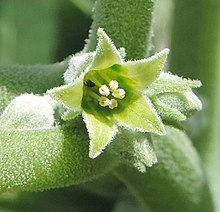Withania somnifera
| Withania somnifera | |
|---|---|

| |
| Scientific classification | |
| Kingdom: | Plantae |
| Clade: | Tracheophytes |
| Clade: | Angiosperms |
| Clade: | Eudicots |
| Clade: | Asterids |
| Order: | Solanales |
| Family: | Solanaceae |
| Genus: | Withania |
| Species: | W. somnifera
|
| Binomial name | |
| Withania somnifera | |
| Synonyms[1] | |
| |


Withania somnifera, known commonly as ashwagandha,[2] Indian ginseng,[3] poison gooseberry,[3] or winter cherry,[2] is a plant in the Solanaceae or nightshade family. Several other species in the genus Withania are morphologically similar.[4] Although thought to be useful as a medicinal herb in Ayurveda and sold in many countries as a dietary supplement, there is insufficient scientific evidence that it is safe or effective for treating any disease.[4][5]
Description
This species is a short, tender perennial shrub growing 35–75 cm (14–30 in) tall. Tomentose branches extend radially from a central stem. Leaves are dull green, elliptic, usually up to 10–12 cm (4 to 5 in) long. The flowers are small, green and bell-shaped. The ripe fruit is orange-red.[4]
Etymology
The species name somnifera means "sleep-inducing" in Latin.[6] The name, ashwagandha, is a combination of the Sanskrit words ashva, meaning horse, and gandha, meaning smell, reflecting that the root has a strong horse-like odor.[4]
Cultivation
Withania somnifera is cultivated in many of the drier regions of India. It is also found in Nepal, China[7] and Yemen.[8] It prefers dry stony soil with sun to partial shade. To propagate it can be grown from seed in the early spring, or from greenwood cuttings in the later spring.[9]
Diseases and pests
Withania somnifera is prone to several pests and diseases. Leaf spot disease caused by Alternaria alternata is the most prevalent disease, which occurs in a severe form in Punjab, Haryana, and Himachal Pradesh. A decline in the concentration of its secondary metabolites occurs by leaf spot disease.[10] A treehopper feeds on the apical portions of the stem, making them rough and woody in appearance and brown in colour.[citation needed]
The carmine red spider mite (Tetranychus urticae) is the most prevalent pest of the plant in India.[11] In recent years, this plant has been serving as a new reservoir host for an invasive mealybug species Phenacoccus solenopsis.[12]
Phytochemistry
The main phytochemical constituents are withanolides – which are triterpene lactones – withanolides, withaferin A, alkaloids, steroidal lactones, tropine, and cuscohygrine.[4] Some 40 withanolides, 12 alkaloids, and numerous sitoindosides have been isolated.[4] Withanolides are structurally similar to the ginsenosides of Panax ginseng, leading to a common name for W. somnifera, "Indian ginseng".[4]
Traditional medicine


The plant, particularly its root powder, has been used for centuries in traditional Indian medicine.[4][7] Mainly due to the poor quality of the clinical research, there is no high-quality evidence that it provides any medicinal benefit as a therapy or dietary supplement, and may cause adverse effects if taken together with prescription drugs.[4][5][13]
References
- ^ "Withania somnifera (L.) Dunal". Tropicos. Missouri Botanical Garden. Retrieved 25 Feb 2012.
- ^ a b "Withania somnifera". Germplasm Resources Information Network. Agricultural Research Service, United States Department of Agriculture. Retrieved 2011-10-29.
- ^ a b "Withania somnifera (L.) Dunal". PROTA (Plant Resources of Tropical Africa / Ressources végétales de l’Afrique tropicale) [Online Database]. Wageningen, Netherlands: Gurib-Fakim A. and Schmelzer G. H. Retrieved 2012-08-07.
- ^ a b c d e f g h i "Ashwagandha". Drugs.com. 2 November 2020. Retrieved 2 February 2021.
- ^ a b "Ashwagandha". MedlinePlus, US National Library of Medicine. 28 August 2020. Retrieved 21 September 2020.
- ^ Stearn, W. T. (1995). Botanical Latin: History, Grammar, Syntax, Terminology and Vocabulary (4th ed.). Timber Press. ISBN 978-0-88192-321-6.
- ^ a b Pandit, S.; Chang, K.-W.; Jeon, J.-G. (February 2013). "Effects of Withania somnifera on the growth and virulence properties of Streptococcus mutans and Streptococcus sobrinus at sub-MIC levels". Anaerobe. 19: 1–8. doi:10.1016/j.anaerobe.2012.10.007. PMID 23142795.
- ^ Hugh Scott & Kenneth Mason, Western Arabia and the Red Sea, Naval Intelligence Division: London 1946, p. 597 ISBN 0-7103-1034-X.
- ^ Deni., Bown (1995). Encyclopedia of herbs & their uses. Montréal: RD Press. ISBN 0888503342. OCLC 32547547.
- ^ Pati, P. K.; Sharma, M.; Salar, R. K.; Sharma, A.; Gupta, A. P.; Singh, B. (2009). "Studies on leaf spot disease of Withania somnifera and its impact on secondary metabolites". Indian Journal of Microbiology. 48 (4): 432–437. doi:10.1007/s12088-008-0053-y. PMC 3476785. PMID 23100743.
- ^ Sharma, A.; Pati, P. K. (2012). "First record of the carmine spider mite, Tetranychus urticae, infesting Withania somnifera in India". Journal of Insect Science. 12 (50): 1–4. doi:10.1673/031.012.5001. PMC 3476950. PMID 22970740.
- ^ Sharma, A.; Pati, P. K. (2013). "First record of Ashwagandha as a new host to the invasive mealybug (Phenacoccus solenopsis Tinsley) in India". Entomological News. 123 (1): 59–62. doi:10.3157/021.123.0114. S2CID 85645762.
- ^ "Ashwagandha". New York City: Memorial Sloan Kettering Cancer Center. 13 April 2018. Retrieved 26 May 2018.
External links
![]() Media related to Withania somnifera at Wikimedia Commons
Media related to Withania somnifera at Wikimedia Commons
